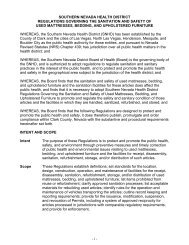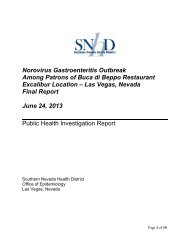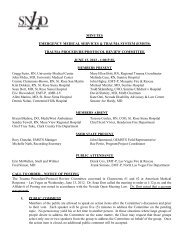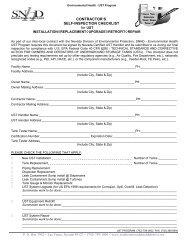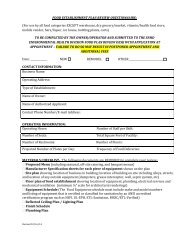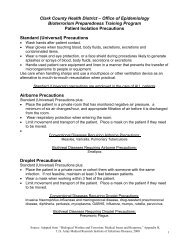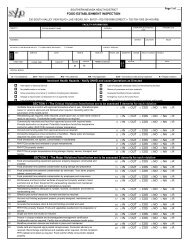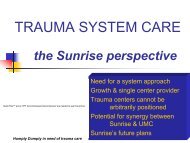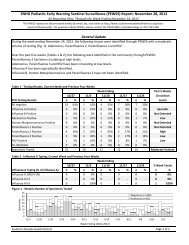Current Trauma Status Report - Southern Nevada Health District
Current Trauma Status Report - Southern Nevada Health District
Current Trauma Status Report - Southern Nevada Health District
Create successful ePaper yourself
Turn your PDF publications into a flip-book with our unique Google optimized e-Paper software.
• From January through April 2004, four Citizens <strong>Trauma</strong> Task Force meetings were held and six<br />
Town Hall meetings were also held<br />
• In March 2004, Sunrise Hospital had a consultation by ACS for Level II trauma center designation,<br />
which led Sunrise to request a “provisional” trauma center designation from the <strong>Nevada</strong> State<br />
<strong>Health</strong> Division because ACS informed them that they needed to observe and review actual trauma<br />
cases at Sunrise<br />
<strong>Current</strong> <strong>Status</strong><br />
<strong>Southern</strong> <strong>Nevada</strong> (or Clark County) is an area with a growing population and 41.4 million visitors a<br />
year (includes Las Vegas, Mesquite and Laughlin). The region is served by the UMC trauma center, a<br />
freestanding Level I trauma center that is one of two trauma centers in the state. Injured patients are<br />
transported to UMC from more than a dozen public and private EMS providers by ground and air<br />
ambulance. Twelve area emergency departments (ED) are also available to treat less severe injuries.<br />
There are four rehabilitation hospitals in <strong>Southern</strong> <strong>Nevada</strong> as well.<br />
The <strong>Nevada</strong> State <strong>Health</strong> Division is designated by state statute as having primary authority over<br />
emergency medical services (EMS) for the entire state, except in Clark County, and for trauma<br />
throughout the state. This authority includes trauma center designation, which is based on ACS<br />
verification. The Clark County <strong>Health</strong> <strong>District</strong> is designated by state statute to oversee the EMS system<br />
in Clark County. This role includes the prehospital component of trauma in <strong>Southern</strong> <strong>Nevada</strong>.<br />
However, it is important to note that neither the State of <strong>Nevada</strong> nor Clark County have a formal<br />
trauma system or trauma plan. It is the intent of this study to recommend the elements of a trauma<br />
system be created for <strong>Southern</strong> <strong>Nevada</strong> and the state as a whole.<br />
<strong>Trauma</strong> Care Components<br />
The National Highway Traffic Safety Administration (NHTSA) has identified the components of a<br />
trauma system in their publication <strong>Trauma</strong> System Agenda for the Future 1 . These are:<br />
• Injury Prevention<br />
• Prehospital Care<br />
• Acute Care Facilities<br />
• Rehabilitation<br />
• Leadership<br />
• Professional Resources<br />
• Education and Advocacy<br />
• Information Management<br />
• Finances<br />
• Research<br />
• Technology<br />
• Disaster Preparedness and Response<br />
The American College of Surgeons Consultation for <strong>Trauma</strong> Systems 2 document, in general, mirrors<br />
the NHTSA model trauma system components but specifies important details on such topics as<br />
system development and legislation. This document additionally outlines credentialing steps needed<br />
to identify progress and the status of each of the key trauma system components.<br />
1<br />
<strong>Trauma</strong> System Agenda for the Future, National Highway Traffic Safety Association, Washington DC, 2002<br />
2 Consultation for <strong>Trauma</strong> Systems , American College of Surgeons , Chicago, IL, 1996<br />
Page 8



